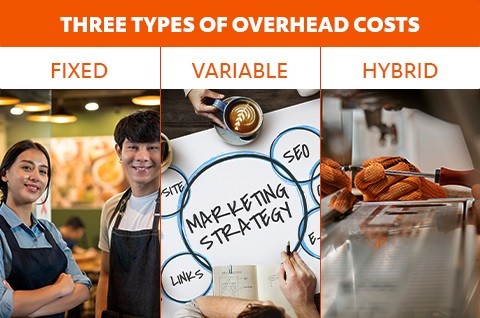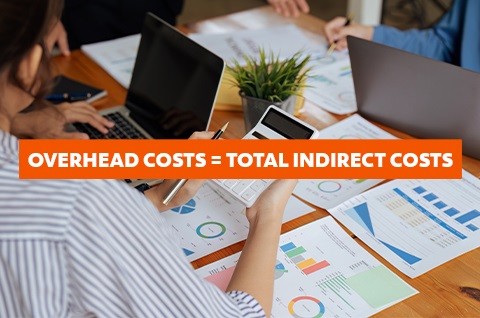What is overhead cost? Essentially, it’s what an entrepreneur spends to run a business smoothly, excluding the actual costs of creating a product or service. For example, ingredients don’t count as you need them to build your restaurant’s menu. Instead, overhead covers ongoing operational expenses like utilities, rent, and employee salaries.
Managing expenses like these is integral to increasing profitability and achieving success in the F&B industry. Learn more about the main types of overhead costs and how to run the numbers. Plus, get practical tips for shrinking its share of your budget.
3 Types of Overhead Costs

Fixed costs are constant despite business changes, while variable overhead is proportionate to your production and sales. Hybrid costs consider both fixed and fluctuating factors.
Most overhead costs fall under three general categories:
- Fixed overhead costs are constant. They rarely fluctuate despite changes to your business or production output. Some examples include rent or lease payments for a restaurant location, property taxes, insurance, and the wages of administrative staff.
- Variable overhead costs are inconstant. They’re directly proportionate to your production and sales, varying as your business changes. Some examples include utilities, marketing, and packaging. So, a restaurant that spends extra on promotional ads during the holidays may see a spike in overhead costs vs previous months.
- Hybrid or semi-variable overhead costs are a blend of the two. Some elements of these costs may remain fixed, while others fluctuate. Some examples include maintenance and repairs, delivery, and utilities with base charges.
Overhead Cost Formula: How to Compute Expenses

Identify your current overhead costs to see where you can cut down.
Before cutting costs, you must evaluate where every peso in your current budget goes. Thankfully, there’s a simple formula for determining your overhead costs:
Overhead costs = total indirect costs
In this equation, the “overhead cost” equates to all indirect expenses your business incurs. “Indirect costs” refer to every peso that doesn’t go into producing your core product or providing your service. For restaurants, this includes everything that isn’t directly involved in preparing a dish, such as marketing materials and cleaning supplies. You’ll want to compile these charges into a spreadsheet and add them up. The total is your current overhead.
Computing for the overhead rate
Now that you know the number you’re working with, you can reevaluate your budget to improve profitability. Start by computing your current overhead rate, a.k.a. the percentage of your funding that goes into overhead costs. Use the formula:
Total Direct Costs / Total Overhead Costs × 100 = Overhead Rate (%)
In this equation, “direct costs” refers to every peso you spend creating your product or offering your service. In the restaurant context, that includes raw ingredients, materials, and the salaries of permanent kitchen staff. Once you have this number, divide it by your overhead costs and multiply the sum by 100. That should give you the current overhead rate.
The overhead rate signifies how much overhead costs your business incurs for every peso spent on direct costs. Use it as the basis for pricing your goods or services profitably.
Sample Computation of Overhead Costs
Begin by adding all your indirect costs. For example:
-
Indirect cost Amount Rent ₱30,000.00
Insurance ₱25,000.00
Wages ₱54,000.00
Social media marketing ₱15,000.00
Repairs ₱6,000.00
Delivery ₱4,500.00
TOTAL ₱134,500
Follow the formula to get the overhead rate:
₱45,325 / ₱134,500 x 100 = 33.70%
How to Reduce Overhead Costs

Determine your bestsellers and plan your inventory restocks accordingly.
Ideally, you’ll want to have as low an overhead rate as possible. This would indicate you’re spending more on your establishment’s main “moneymakers” (a.k.a. your profit drivers) than on any of the “extra stuff” behind the scenes. If it’s at the higher end, you should look for ways to reduce overhead expenses efficiently. Start with these.
Tip #1: Streamline inventory and control waste.
Keep tabs on your inventory to ensure your bestsellers are always available. Review stock levels, track usage, and order supplies to meet demand without overstocking. If your establishment goes through a tub of Lady's Choice Real Mayonnaise a week, order only four to five tubs to save room for other essentials. Then, train your staff on best practices that limit food waste, such as proper portion control and thoughtful menu planning that maximizes ingredients.
Tip #2: Negotiate supplier contracts and leases.
Find mutually beneficial terms with your suppliers, landlords, and other partners. Perhaps your produce supplier will offer discounts or first dibs on their freshest goods in exchange for bulk purchases. Ask your landlord if they’re open to renegotiating lease terms and shouldering more upkeep costs after you’ve proven yourself to be a reliable tenant.
Tip #3: Outsource tasks and optimize staff scheduling.
Check what your establishment needs daily. Some tasks, such as deep-cleaning and bartending, may not require full-time staff. Whenever possible, outsource these jobs to minimize in-house labor costs. For staff schedules, observe how your business runs for a few months. Use this information to prevent over- or understaffing in the future.
What is overhead cost, and how do you manage it? Well, now you know! Cost analysis, expense tracking, and efficient kitchen management are keys to keeping indirect expenses low. Continue adjusting your strategies to ensure your business is always booming.






